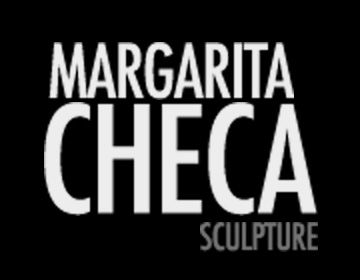THE WOOD OF MARGARITA
By Doris Bayly
The olive wood has a soft perfume. The aroma is so delicate that you can be beside a worked piece of wood and not be aware of the very particular atmosphere it creates. As though the soul of the trunk could speak, far from the tree.
The sculptor Margarita Checa doesn’t only use olive wood for the sculptures she has been exhibiting, the past several days, at the Lucia de la Puente gallery. In some pieces she combines it with mahogany or cedar, with the olive always as a base. On the screen titled “The Three Graces,” an inlay of fragments of bull’s horn interrupts the broken lines of the wood. It gives off no aroma.
“The Three Graces,” three tall, graceful women, dressed in robes that could be a curious parody of high couture, are presented in the distinct sections of the screen in the manner of models on the catwalk, form the front and the back, in positions that recall certain attitudes of modern dance. The code contained in the screen of “The Three Graces” obeys a clear tendency toward fun, if not irony, to the point of being festive. This is the freshest piece of the Margarita Checa’s show titled “The Song of Life.” The other sculptures contain various aspects of femininity: sensuality (“Salome”), intelligence (“La Mente”), motherhood (“The Warrior”) and the intimate mysteries
The symbolism Checa uses in her sculptures has been associated with figures made by primitive cultures. The long foreheads, large, rough feet and big hands make one think of ancient African women, from tribes far from civilization. She says it nourishes the collective unconscious that, if it has an evident connection with the woman of the earliest times, is also linked to the symbolic elements used by the pre-hispanic cultures that developed in these lands, such as the hummingbird and the serpent.
More than the cleanness of the lines and a neat display of extraordinary technical ability—that has solid roots in the vision and lines of Christina Galvez—, the pieces of Margarita Checa, kept brief by necessity of the sensuality of the wood, speak (and not so quietly) of the soul of their characters. They speak.
[Translation of Captions]
- Margarita Checa, Peruvian sculptor, in her studio on Villa.
- “The Hidden Place,” Olive wood
- “The Threshold of the Unknown,” piece shown in the Panamanian gallery, Arteconsult.
- “The Three Graces,” Wood screen with laminated inlay of bull’s horn.
